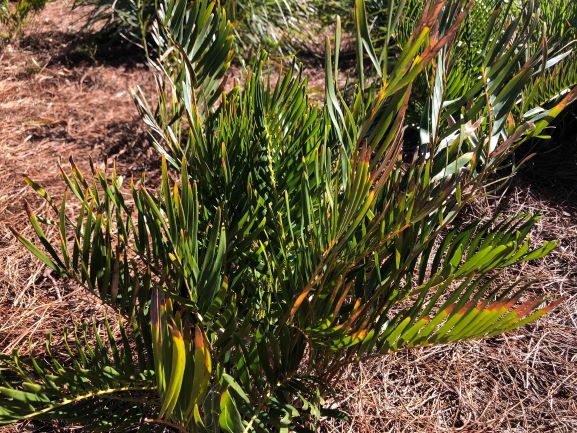
by Carrie Stevenson | Mar 11, 2021
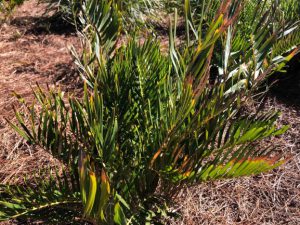
The ancient cycad, coontie, is a hardy and attractive plant for Florida landscapes. Photo credit: Carrie Stevenson, UF IFAS Extension
The plant has a crazy-sounding name, more like some little animal you’d find in Australia than a native plant. However, an ancient Florida plant it is, and a tough one at that. Growing close to the ground, it most resembles a large fern or a sago palm, if the sago had smooth, rounded leaf edges. Like the sago, the coontie (Zamia floridana) is a cycad—a group of palmlike plants that have been around so long that triceratops and stegasauruses ate them! Coonties are the only cycads native to North America, found in the states and island nations like Cuba and the Bahamas.
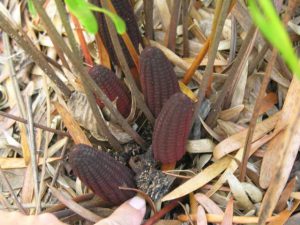
Male cones (strobilus) of coontie are thinner and shorter than female cones. Photo credit: Dan Culbert, UF IFAS
Another interesting feature of the coontie is its seed cones. These are large reddish orange cones that resemble magnolia seedpods. Both sexes of plant produce them in clusters ranging from one to five of the 2-7” long cones. Cones from the male produce pollen, while females produce seeds. If you are interested in attracting wildlife to your yard, the coontie provides good low-growing cover for birds and small mammals. It is also the preferred food for the caterpillar of the rare Atala butterfly. Members of the Timucuan and Calusa tribes ground up the starchy root of the coontie as a flour. However, the root contains a toxin and if it is not removed first, ingestion could result in severe abdominal pain and vomiting. From the late 1880’s through World War I, a large starch industry existed in Florida, producing flour from the coontie root.
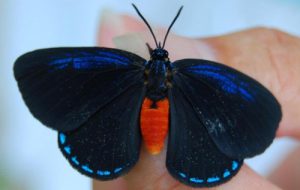
Adult female atala butterfly, showing royal blue streak on forewings. Photo credit: Sandy Koi, University of Florida
At home in drier soil conditions like oak hammocks and pinelands in north central Florida, these plants can also adapt to a variety of soil pH types. Coonties are drought, cold, and salt tolerant, thus a great landscape choice for coastal landscapes near the Gulf or a bay. The plants are very long-lived and adaptable. In fact, the book Florida’s Best Native Landscape Plants notes it is “Very hardy and easy to care for. Will grow well in any part of Florida, even outside its normal range. An exceptional replacement for the closely related, often used, but non-native sago palm.” In other words, this is an ideal landscape plant that should be used more throughout Florida.
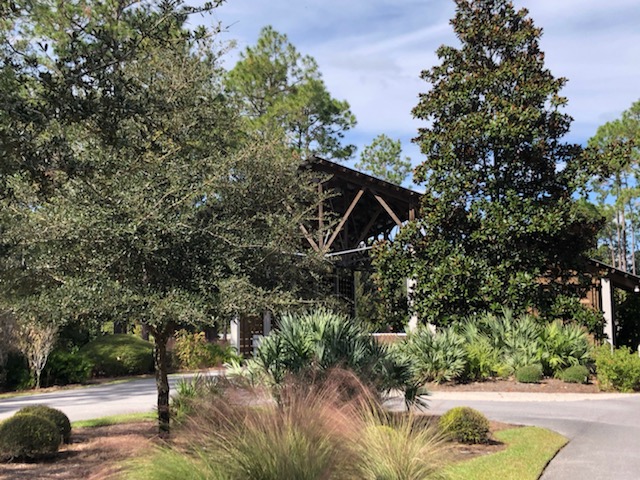
by Stephen Greer | Mar 11, 2021
Landscaping with native plants brings opportunities and challenges while adding diversity and beauty to the home. There are many factors that come into play to successfully grow plants. As gardeners, we all want things to look exceptional for all to enjoy. Native plants have evolved over long periods of time naturally in a given region without intervention, bringing much needed diversity to natural areas and landscapes. A big plus for natives are the flowers presented for the local bee populations and other pollinators assisting in the continuation of the plant species potentially established over thousands of years.
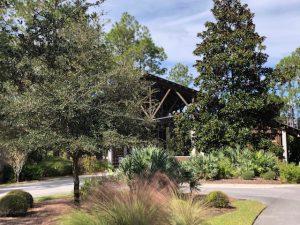
Landscape of Native Plants. Photo Credit: Stephen Greer, UF IFAS Extension Santa Rosa County
Native plants have evolved in natural communities and are found to be interdependent not only plant to plant yet with soil type, soil microbial activity through bacteria and fungus, specific site location and others though biodiversity of these living communities. Part of this community is often referred to as the soil web creating the connections of billions upon billions of organisms in the critical survival of the plants, insects and other animals we see. The first steps when considering native plants for your landscape are to do your research and contact your local Extension office. Some questions to consider may include: Does it grow best in well drained sand or wet soils or require high in organic matter? Will full sun, part-shade to full shade be needed?
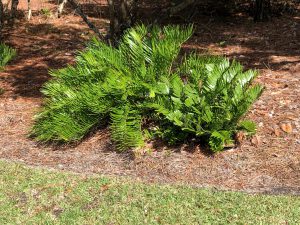
Coontie Palm in Landscape. Photo Credit: Stephen Greer, UF IFAS Extension Santa Rosa
Plants that are native and non-native are often seen in the same landscape setting. Consideration should be taken to determine if either of the groups are aggressive in expanding beyond the intended plant setting. Before moving on, non-native is in reference to plants that are introduced to a plant community that came from a totally different plant location. An example of that location being hollies from southeast Asia or South America or even a different area of the United States. Many have been researched and observed for many years under managed situations before being introduced into the local landscape nursery markets. Once in a while a plant is introduced that has not gone through a long rigorous study and can become naturalized outside of its normal plant zones and establish as an invasive species. This highly adaptable aggressive habit can, and often will colonize a given location out competing the native plants. Kudzu is a good example of an invasive exotic plant that is naturalized in the southeastern U.S.
As gardeners there are opportunities to have positive impacts on some of these diminished native habitat areas that can be threatened by growth of urban and rural areas in Florida. Establishing native plants areas into the landscape with proper soil preparation, managed water needs and more gives that chance for this interdependent system of plants, animals and nonliving elements to remain established with big impacts.
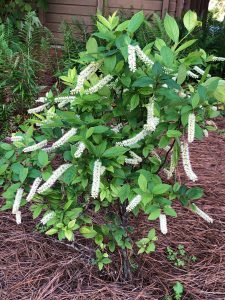
Virginia Sweetspire. Photo Credit: Stephen Greer, UF IFAS Extension Santa Rosa County
Native plants can be a working part of the garden from wonderful flowers, season color change, leaf foliage of multiple sizes and shapes to feed the insects that feed the birds, leaves and nuts that feed so many other animals for us to enjoy seeing. Balance is such a big part of being a successful gardener. Remember not all native plants are suitable for landscape spaces, do your research and ask for assistance from the experts to determine if it is the right plant for the right place.
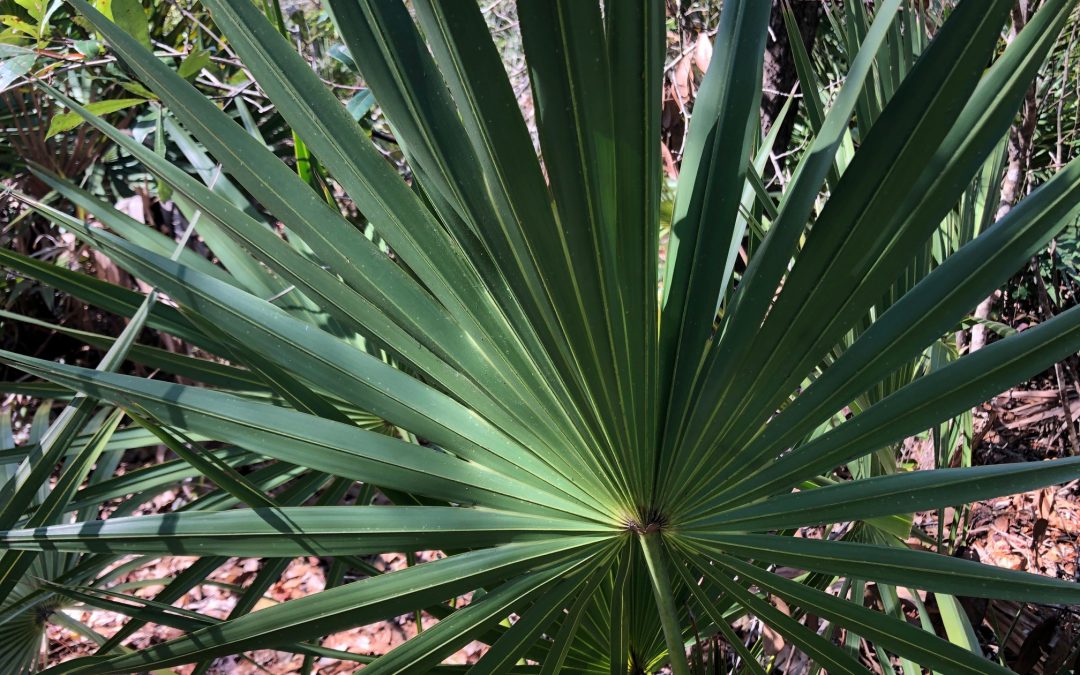
by Carrie Stevenson | Mar 4, 2021
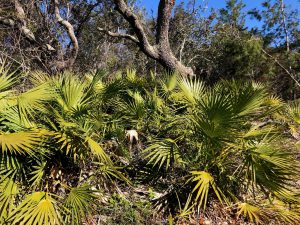
Saw palmettos provide crucial ecosystem services for the forests of Florida. Photo credit: Carrie Stevenson, UF IFAS Extension
The saw palmetto (Serenoa repens) is a classic symbol of Florida. Found in upland habitats and just to the edge of wetlands, their brilliant green fronds stand out in the mostly brown pine flatwoods and oak hammocks to which they are endemic. The shrublike saw palmetto thrives in sandy soils, is highly salt tolerant, and is tough as nails. The plant’s root is one of the sturdiest in nature. Imagine the trunk of a palm tree laid horizontally and just underground—this is the plant’s base. This root system lends stability and tolerance to nearly every tough Florida growing condition, including drought, floods, and fire. Saw palmettos are extremely slow growing, and there are stands in south Florida in which botanists have found individual plants and clonal colonies several thousand years old. Saw palmettos are one of the few members of the palm family that thrive in the panhandle. While many palm trees are planted here, most are native to more southern climates with warmer winters and karst geology—a higher pH soil composed of limestone and often prone to springs and sinkholes.
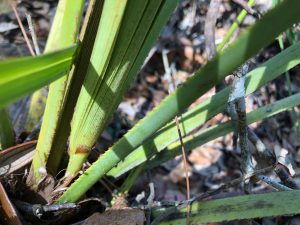
The tough, serrated edges of the saw palmetto gave it its name. Photo credit: Carrie Stevenson, UF IFAS Extension
The saw palmetto’s name comes from the serrated, saw-like edges of the stem. These are quite tough and can cut your skin and clothing if not careful. A very similar palmetto, the bluestem, grows in wetter soils. It can be differentiated from the saw palmetto because its stems are smooth—no serrated edges—and the whole plant has a bluish cast to it.
The saw palmetto has long been prized by humans for its practical uses. The “ethnobotanical” history of this plant has ties to Native American tribes who used the fronds for roofing and building material, brooms, fishing nets, and fans. The leaves were utilized for rope, and multiple plant parts for food and medicine. The dark blue/black fruit of the saw palmetto was considered an aphrodisiac and has been used to treat prostate problems for centuries. According to a UF publication on the saw palmetto, “Modern day development of a purified extract from the berries greatly improves symptoms of enlarged prostate. Florida is the biggest source and producer of saw palmetto products. With about 2,000 tons harvested from South Florida and exported to Europe each year, the fruit crop estimate is $50 million a year in the state.”
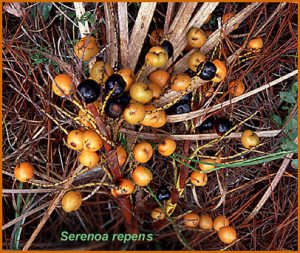
Saw palmetto berries are a staple of Florida wildlife diets. Photo credit: UF School of Forest Resources & Conservation
Besides the human uses, saw palmetto serves as a crucial component in the diet of native wildlife. Florida black bears, panthers, 20 other species of mammals, over 100 types of birds, 25 amphibians, over 60 reptiles, and countless insects depend on saw palmetto berries as part of their diet. The wild harvest of saw palmettos is regulated by the state to prevent overharvesting and negative impacts to the wildlife food supply.
Saw palmettos also make a great home landscape plant, as they can grow in a wide variety of conditions, provide wildlife food and habitat, and add visual interest. There are few plants more “low-maintenance” than an established saw palmetto. A mature one is so difficult to remove, that it’s best to leave it where it is anyway!

by Danielle S. Williams | Mar 4, 2021
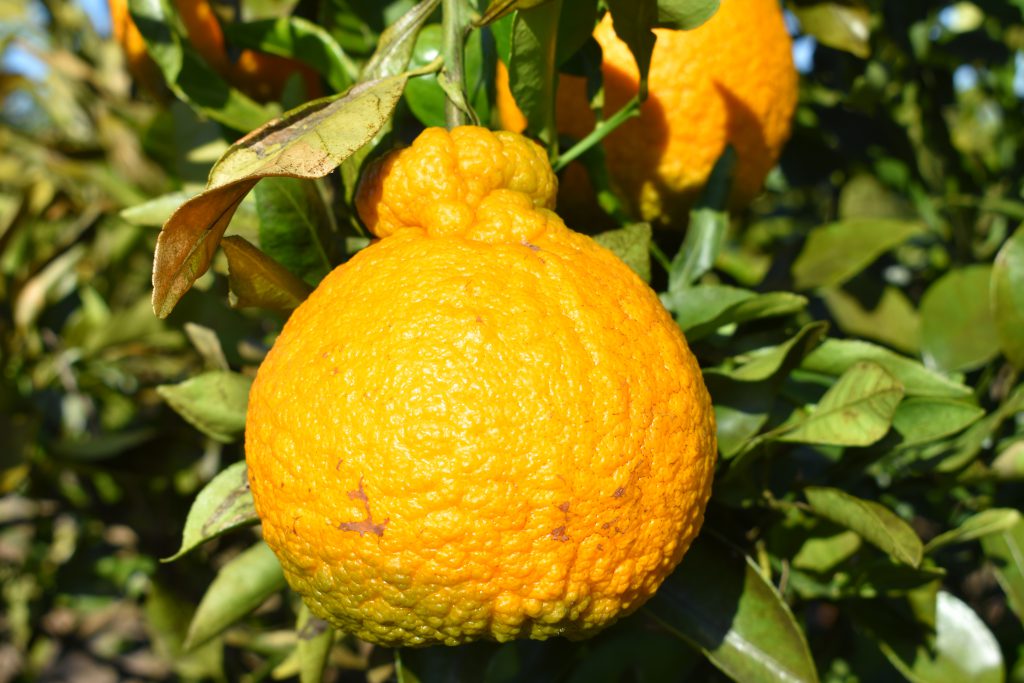
Shiranui mandarin
You’ve likely seen them in the grocery stores, and you’ll see them now through April. A large, lumpy (some may say ugly) piece of orange fruit with a bump near the stem. But what exactly is this special looking fruit? It’s a Shiranui mandarin!
The name ‘Shiranui’ is the generic term for this variety of citrus. You may have seen the same variety of mandarin marketed in grocery stores as ‘Sumo Citrus’ which is a trademarked name for the variety. In Japan, they are widely known as ‘Dekopons’. No matter what you call them, they are easily recognized by their distinctive appearance.
The Shiranui mandarin is a hybrid between a Ponkan tangerine and a Kiyomi Tangor (sweet orange x satsuma mandarin). They are easy to peel, sweet, and seedless. Shiranuis are considered to be one of the sweetest and most flavorful varieties of citrus on the market. The fruit are large and have a large protruding bump near the stem that resembles the top knot hairstyle of a Japanese sumo wrestler (hence the trademarked name ‘Sumo Citrus’).
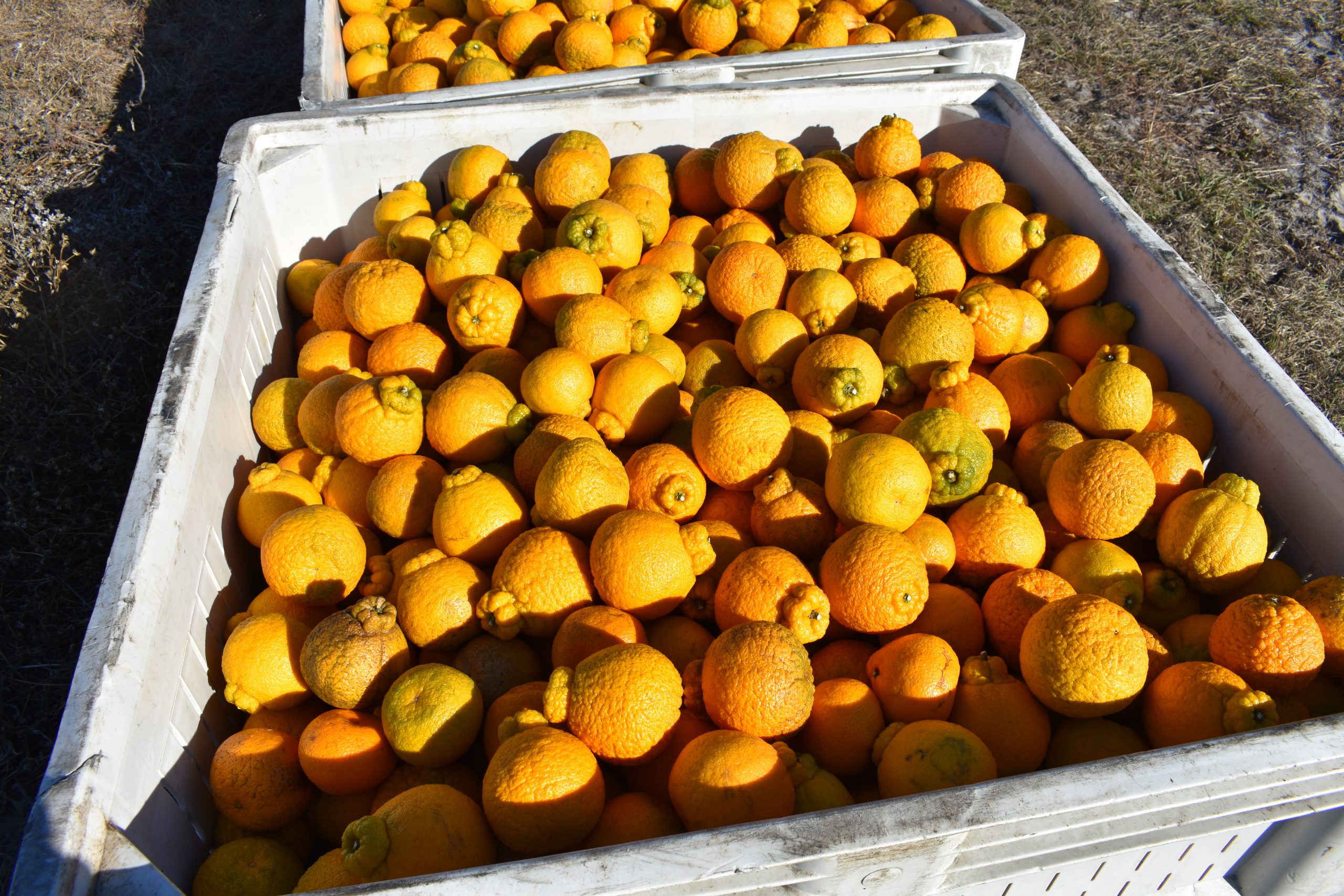
While the majority of Shiranui mandarins on the market are grown in California, the variety can be grown here in Florida and several citrus growers in North Florida and South Georgia have began to experiment with plantings in the region. Homeowners, too, can try their hand at growing the variety as many Florida certified citrus nurseries carry the variety. For more information on different citrus varieties, contact your local UF/IFAS Extension Agent.
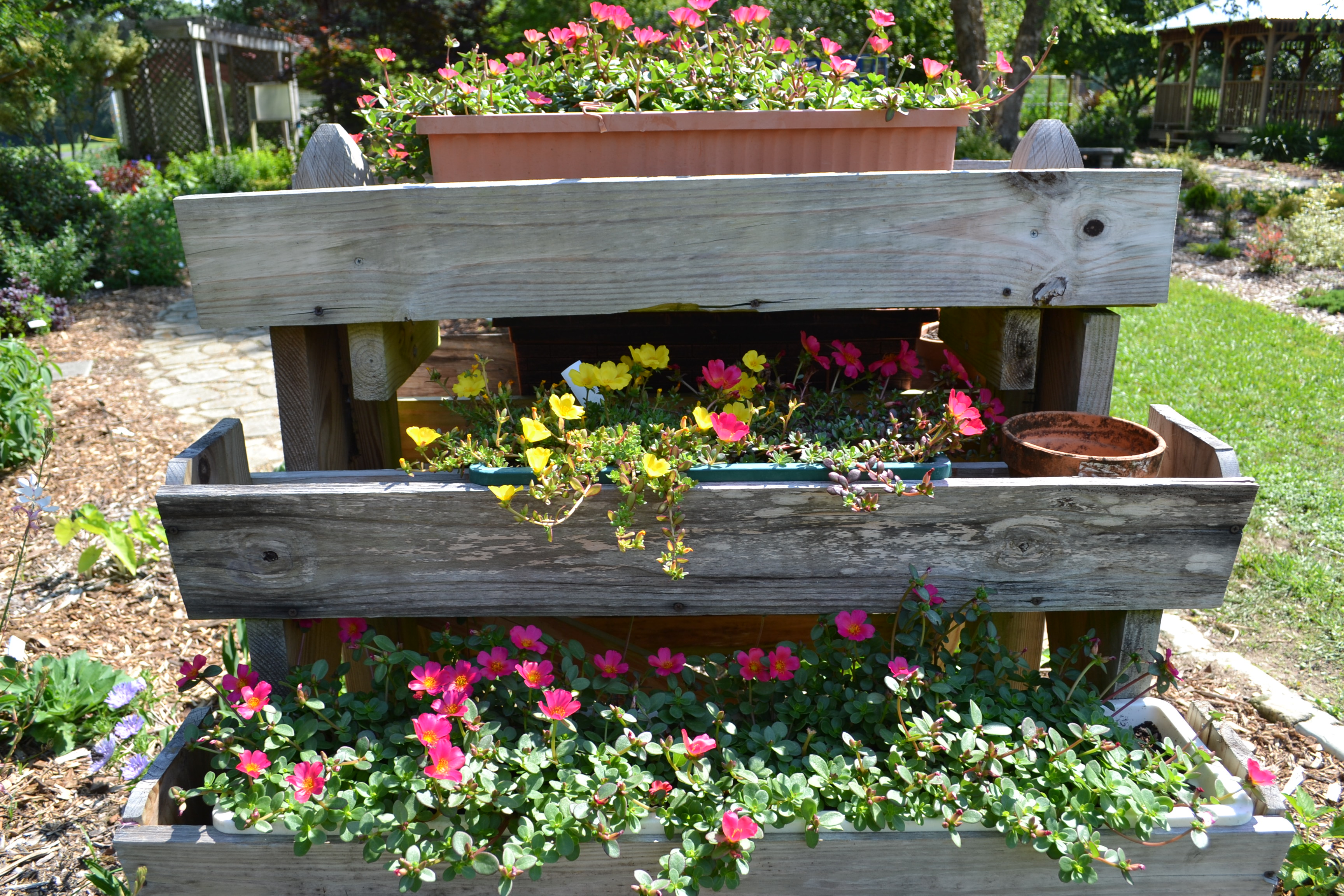
by Matt Lollar | Mar 4, 2021
Plant with Purpose: Written by Rachel Mathes
Last spring, we were all ready to host another Open House and Plant Sale on Mother’s Day weekend. When the realities of the pandemic became clear, we canceled the event for the safety of everyone involved. We typically have more than 500 visitors and dozens of volunteers on site. This year we are happy to announce we have adapted our annual fundraiser to a monthly learning and growing opportunity for the whole community.
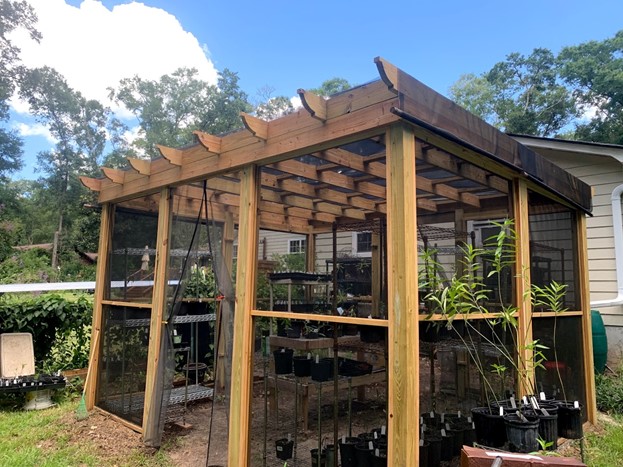
Master Gardener Volunteer Jeanne Breland is growing native milkweed in her monarch exclusion fortress for a Plant with Purpose talk and sale in the spring. Previous years’ milkweed have been eaten by monarch caterpillars before the sale so Jeanne has built her fortress to get the best results. Photo by Rachel Mathes
Our Master Gardener Volunteers will be teaching Thursday evening classes on particular plant groups throughout the year in our new series: Plant with Purpose. Topics will range from milkweed to shade plants to vegetables and herbs for different seasons. Attendees can attend the talks for free and grow along with us with the purchase of a box. These boxes are modeled after community supported agriculture (CSA) boxes you can purchase from local farms. Buyers will get a variety of the plants discussed in the plant lesson that week. For example, in our first event, Growing a Pizza Garden, we will have two tomato plants, two pepper plants, and one basil plant available for $20. Throughout the year, prices and number of plants will vary depending on the topic.
We hope with this new model of presentations and plant sales will enable us to remain Covid-safe while still bringing horticulture education to the community. Classes will be held on Thursday evenings from 6-7 pm via Zoom. Register on our Eventbrite to get the Zoom link emailed to you before each talk. Plant pick up will be the following Saturday from 10 am to noon. Master Gardener Volunteers will load up your plant box in a contact-free drive thru at the UF/IFAS Leon County Extension Office at 615 Paul Russell Rd.
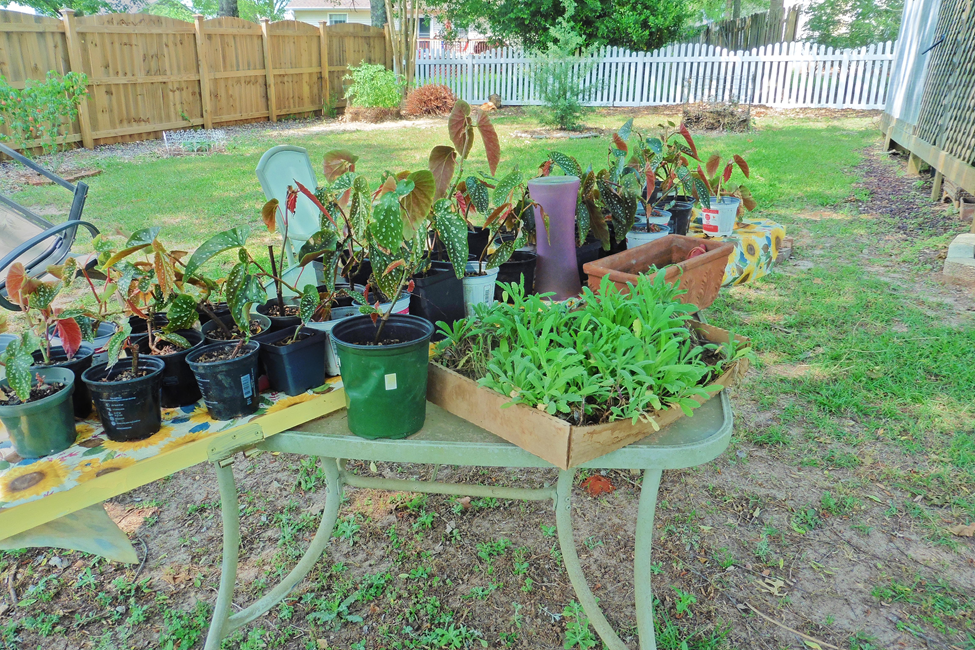
Propagation of angel wing begonia and other plants by Joan Peloso, Master Gardener Volunteer.
Master Gardener Volunteers are already growing plants for you to purchase throughout the year. Landscape plants, herbs, vegetables, shrubs and even trees will be available later in the year. Funds raised from this series help fund our Horticulture programming. Some notable programs that will benefit from Plant with Purpose include our Demonstration Garden, 4-H Horticulture Club, the Veterans’ Garden Group at the VA Tallahassee Outpatient Clinic, and various school gardens we help support throughout Leon County.
In the last year, we have adapted many of our programs to meet virtually, and even created new ones like our Wednesday Webinar series where we explore different horticulture topics twice a month with guest speakers from around the Panhandle. While we still can’t meet in person to get down in the dirt with all of our community programs, we hope that the Plant with Purpose series will help fill the hole left by our cancelled Open House and Plant Sale. Join us for the first installment of Plant with Purpose on Thursday March 18th from 6-7pm. Pick up for purchased plant boxes will be Saturday March 20th from 10am-noon.
To register for this event and other events at the Leon County Extension Office, please visit the Leon County Extension Office Events Registration Page.


















